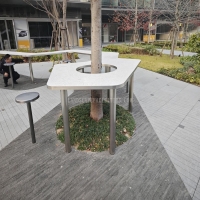Welcome to the website for landscape facilities products and knowledge.
What are the pros and cons of using reclaimed wood for a landscape bar counter?
The allure of a landscape bar counter is undeniable. It transforms an ordinary backyard into an entertaining oasis. When selecting the material for this centerpiece, reclaimed wood often emerges as a top contender, radiating a sense of history and rustic charm. However, its use outdoors comes with a unique set of advantages and drawbacks that require careful consideration.
On the pro side, the benefits are compelling. Firstly, reclaimed wood boasts an unparalleled aesthetic. Each plank tells a story through its weathered texture, nail holes, and variations in color, creating a one-of-a-kind bar top with instant character that new lumber cannot replicate. Secondly, it is an profoundly eco-friendly choice. By repurposing old barn wood, factory beams, or decking, you divert waste from landfills and reduce the demand for virgin timber, making your project a statement in sustainability. Thirdly, this material is often exceptionally durable. Woods like old-growth heart pine or oak were harvested from dense, mature trees and have already endured decades of weathering, resulting in a stability and strength that can be superior to many new softwoods.
Conversely, the cons are significant and primarily concern maintenance and practicality. The most pressing issue is its potential vulnerability to the elements. While it's already weathered, reclaimed wood must be meticulously cleaned, treated, and sealed with a high-quality, outdoor-rated sealant to protect it from moisture, UV damage, and insects. Without this rigorous preparation and ongoing maintenance, it can warp, crack, or rot. Secondly, there is a risk of contaminants. Wood from old industrial or agricultural sites may harbor chemicals, pesticides, or lead-based paint residues, necessitating professional sourcing and treatment to ensure it is safe for use. Finally, cost can be a surprise. While the material itself is "reclaimed," the process of sourcing, de-nailing, planing, and treating it is labor-intensive, often making a reclaimed wood counter more expensive than one made from new, high-quality composite or tropical hardwood.
In conclusion, a reclaimed wood landscape bar counter is not a simple DIY project. It is a commitment to a specific aesthetic and sustainable ethos. Its success hinges on understanding the investment required—not just in money, but in diligent preparation and lifelong upkeep. For those willing to embrace its history and its needs, it results in a deeply personal and captivating outdoor feature. For others seeking lower maintenance, alternative materials might provide a more practical solution.
Related search:

Recommendation
An outdoor bar counter with stainless steel and terrazzo materials in an irregular shape